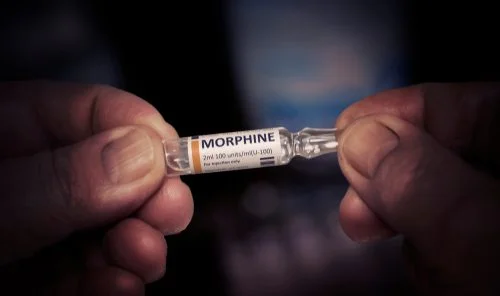Morphine
Morphine is an opioid alkaloid that is used for relieving moderate to severe pain. It is a habit-forming substance and care should be taken exactly as directed by your doctor.

Common Brand Names: MSiR, Duramorph, Infumorph, Kadian, and MS-Contin, Statex, Oramorph, Sevredol
Derived from the plant Papaver somniferum or the opium poppy, morphine is one of the most common opioid analgesics in use today. It is mainly used for managing moderate to severe pain and comes in a variety of preparations, including oral solutions, immediate- and extended-release tablets, capsules, and injectables.
Morphine, like other opioid drugs, binds to mu, kappa, and delta receptors. These receptors can be found in both the central and peripheral nervous systems and produce a variety of effects when activated. These can include analgesia, euphoria, sedation, and slower respiration.
Morphine is classified as a Schedule II substance under the federal drug scheduling system. This is due to its high potential for abuse, which can lead to severe psychological or physical dependence.
What Morphine Is Used For
Morphine is FDA-approved for pain management, more specifically in the treatment of acute or chronic moderate to severe pain. Particular examples for its use include palliative or end-of-life care, pain management of cancer patients, and the treatment of vaso-occlusive pain such as in sickle cell disease.
In emergency settings, morphine is also a first-line agent for acute coronary syndrome, especially in myocardial infarction (MI). Its analgesic properties, along with its lowering effects on heart rate, blood pressure, and venous return, have been proven to increase survival among MI patients.
Off-label use of morphine includes any condition that causes pain, such as musculoskeletal, abdominal, respiratory, and neurologic diseases such as headache. Though rare, some physicians may prescribe morphine as a sedative, oftentimes in combination with a benzodiazepine such as lorazepam.
How Do People Abuse Morphine?
When used without the guidance of a medical professional, morphine can present a very high risk of a drug overdose. The drug’s illicit use or abuse is usually done in the following ways:
- Ingestion of morphine tablets or capsules beyond dosages prescribed by physicians
- Crushing morphine pills and snorting the resulting powder
- Intravenous injection of morphine without the guidance of a medical professional and beyond recommended amounts.
- Taking morphine in conjunction with another substance such as alcohol or other opioids.
Morphine’s potent effects can bring a highly pleasurable sensation that can easily create a craving for its repeated use. As the craving becomes even more intense, dependence and then addiction usually follow.
Morphine Drug Interactions
As with other potent opioids, morphine should be administered with caution to prevent negative effects associated with its concurrent use with other substances. For example, taking it with central nervous system (CNS) depressants may cause respiratory depression, hypotension, profound sedation, and coma. Some of these include:
- Phenothiazines
- Tricyclic antidepressants
- Tranquilizers
- Sedatives
- Hypnotics
- Antimetics
- Muscle relaxants
- Alcohol
Meanwhile, using morphine with mixed agonist/antagonist opioid analgesics may reduce the efficacy of the latter. These include:
- Pentazocine
- Nalbuphine
- Butorphanol
Morphine use may also interact with cimetidine, causing apnea, confusion, and muscle twitching. And lastly, its use with monoamine oxidase (MAO) inhibitors is known to have a noticeable additive effect, and should not be taken within 14 days of each other.
Morphine Side Effects
Morphine shares several short-term side effects with other opioids, including:
- Drowsiness
- Stomach pain and cramps
- Dry mouth
- Headaches
- Agitation
- Confusion
- Nervousness
- Loss of appetite
- Changes in mood
- Miosis or constriction of pupils
- Difficulty or pain associated with urinating
Meanwhile, other side effects can be more severe and should immediately warrant the attention of a trained professional:
- Cyanosis or the bluish to purplish skin
- Arrhythmia or changes to the heartbeat (tachycardia or bradycardia)
- Chest pain
- Difficulty breathing or swallowing
- Fainting
- Seizures
- Fever
- Vomiting
- Diarrhea
- Impotence or inability to get or keep an erection
- Irregular menstruation
- Decreased libido
- Swelling of the eyes, face, mouth, lips, or throat
- Development of hives, rashes, or itchiness
Possible Long-Term Effects of Morphine
Prolonged, chronic use of morphine can lead to tolerance and dependence. The presence of morphine constantly activates the brain’s reward system and triggers its euphoric effects, making a person constantly crave the drug despite its side effects. However, misuse of morphine over the long term can also lead to more deleterious effects on the body, including:
- Shifts in mood
- Changes in hormonal levels and endocrine function
- Alterations in autonomic nervous system function (which may include heart rate, blood pressure, respiration, and sexual arousal)
- Decreased gastrointestinal motility
- Reduction in the growth of fetus in pregnant women
- Withdrawal syndrome in infants born of women who use the drug
- Physiological and behavioral abnormalities in offsprings of women who use the drug
Signs of Morphine Overdose
When taken beyond clinically acceptable amounts, morphine can cause an overdose. Immediate and obvious signs of a morphine overdose include the following:
- Slow, shallow, or irregular breathing
- Difficulty breathing
- Bradycardia or slower heartbeat
- Sleepiness
- Limp muscles
- Cold, clammy skin
- Miosis or small pupils
- Blurred vision
- Nausea
- Fainting
- Unresponsiveness or inability to wake up
Immediately contact 911 or your local emergency services if you or anyone near you are exhibiting signs of a morphine overdose. Moreover, if you or a member of your family is medicating on morphine or is at risk of misusing it, consult your doctor and discuss the possibility of getting a rescue drug called naloxone. It can be used to reverse the potentially life-threatening effects of an opioid overdose.
Signs You May Be Addicted to Morphine
The Fifth Edition of the Diagnostic and Statistical Manual of Mental Disorders (DSM-5) is a handbook used by healthcare professionals in the United States as a guide to diagnose mental disorders, including substance use disorders. The DSM-5 provides a criteria for substance use disorders, which can be used to determine if an person has developed an addiction to morphine:
- Taking morphine in larger amounts or for longer than intended
- Wanting to reduce or stop using morphine, yet being unsuccessful
- Spending excessive amounts of time getting, using, or recovering from use of morphine
- Intense cravings and urges to use morphine
- Morphine use causing inability to manage commitments or obligations
- Continuing morphine use despite having interpersonal or relationship problems
- Giving up important activities because of morphine use
- Repeated use of morphine even when it puts you in danger
- Continuing morphine use despite the possibility of it worsening physical or psychological problems
- Needing increased morphine dosages to achieve the desired effect (increased tolerance)
- Development of withdrawal symptoms, which can be relieved by using more morphine
Morphine Withdrawal Symptoms
Morphine withdrawal symptoms can be intensely unpleasant and even dangerous, so it will be best to avoid stopping use of the drug without consulting a medical professional. These symptoms can include:
- Chills
- Sweating
- Runny nose
- Watery eyes
- Depression
- Irritability
- Insomnia
- Agitation
- Anxiety
- Headaches
- Nausea and vomiting
- Loss of appetite
- Fever
- Increased blood pressure
- Diarrhea
- Hot or cold flushes
- Sweating
- Insomnia and anxiety
- Irregular breathing
- Muscle cramps
Withdrawal symptoms such as those listed above are clear signs of morphine dependence and are similar to those associated with dependence on other opioids. Although dependence on a substance does not necessarily equate to addiction, abruptly stopping use of the drug can cause these symptoms of withdrawal, many of which can be very dangerous.
Thankfully, medical detox facilities have specialists who know how to identify these signs and who can help individuals through a specially designed detox program. By safely tapering off morphine, you can reverse your body’s dependence on the drug and safely quit its use.
Detoxing from Morphine
A morphine detox program can greatly minimize the intense withdrawal symptoms you might experience after becoming dependent on the drug. Detoxification, or detox for short, refers to the process of safely eliminating the substance you’ve developed a dependence on from your system while also managing the symptoms of withdrawal. When a detox regimen is done correctly, you can expect to discontinue your use of the drug in a more gradual way and in a safer manner.
Throughout the process, medical professionals will be monitoring your progress at your chosen facility. They will also be responsible for providing you with the necessary interventions to help you wean yourself off morphine. As needed, you may be provided with symptomatic medications, nutritional supplements, and IV fluids.
Getting Treatment for Morphine Addiction
Opioids, which includes morphine, are responsible for nearly 500,000 fatalities in the United States from 1999 to 2019. With morphine’s intense euphoric effects and high potential for abuse, it’s best to seek help if you or a loved one may be showing signs of addiction to the substance.
Depending on your condition, a morphine addiction treatment program can either be on an inpatient or outpatient basis:
- Inpatient morphine addiction treatment: Considered as the most intensive option, inpatient programs are best for those who require round-the-clock monitoring to guarantee the treatment’s success. In this setting, morphine therapy will include medication-assisted treatment, and may also include individual therapy, group and family therapy, as well as drug education sessions. Psychotherapeutic interventions can help you pinpoint personal obstacles that can negatively affect your progress and while also equipping you with the means to minimize your risk of future relapses.
- Outpatient morphine addiction treatment: This option is typically for those who have been identified to be low-risk patients. In an outpatient addiction treatment program, you will be allowed to stay in your home and continue with your regular daily routines such as going to school or work while attending scheduled therapy and counseling sessions at your chosen treatment center. This is best suited for people with milder forms of addiction and who may also have their own robust support networks where they live.
While morphine has proven its usefulness in the medical field, the potential for its misuse cannot be ignored. Its legitimate clinical uses allow its acquisition under the guise of medical treatment to be one of the easiest ways to illegally gain access to it. Individuals who become addicted to morphine will need to undergo a specialized treatment program to recover from its addictive properties.
Call Now to Start Your Journey to Recovery
The journey to full recovery from morphine addiction can be extremely long and difficult, but it is not impossible. Better Addiction Care is here to guide you as you begin your treatment process. If you or someone you know is dealing with morphine use disorder, call us now at (800) 429-7690 to speak to a recovery support advisor. They will be able to check your insurance status and recommend the best possible course of action regarding how to finance your treatment. They can also help you find a suitable treatment center.
Note that even if you don’t currently have insurance, there are plenty of other ways to get the treatment you need. The advisor who will answer your call can provide further guidance regarding the options available to you.
The Origins and History of Morphine
In 1806, German chemist Friedrich Wilhelm Sertürner first produced opioid alkaloids from the plant Papaver somniferum, more commonly known as the opium poppy. The extracted compound was a yellowish-white crystalline which was believed to be the active ingredient in opium. Sertürner tested the compound on animals, and these experiments later demonstrated its sedative properties.
After a few human experiments, Sertürner concluded that the compound had pain relief and euphoric effects. In higher doses, it led to psychiatric manifestations and caused slowed breathing, nausea, vomiting, and cough depression. The chemist eventually named the compound morphine, as a reference to Morpheus, the Greek God of dreams.
In the mid-19th century, morphine was commercially produced and began to be widely used as a pain reliever and as substitution therapy for opioid addiction. Not long after, however, morphine addiction became widespread. During the Civil War, many soldiers fell victim to morphine-derived substance use disorder, and the term “Soldier’s Disease” was coined to pertain to morphine dependence among its users. The rise in the use of hypodermic needles as a vehicle for morphine delivery also greatly contributed to this alarming situation.
As a result, in the early 20th century, governments all over the world authored and passed legislation to control morphine addiction. Some United States federal laws include the Harrison Narcotics Tax Act in 1914 and the Controlled Substances Act in 1971. These policies aim to regulate and tax the production and distribution of opioids and other drugs with a high potential for addiction. In the United States, morphine is currently classified as a Schedule II controlled substance under the Controlled Substances Act. It is also considered a Schedule I drug under the Single Convention on Narcotic Drugs according to international law.






